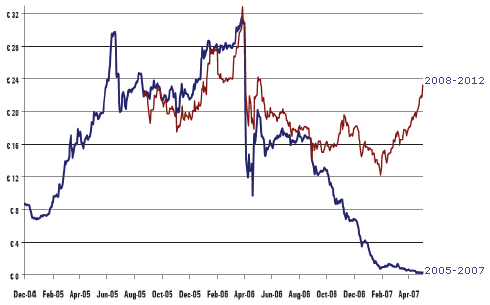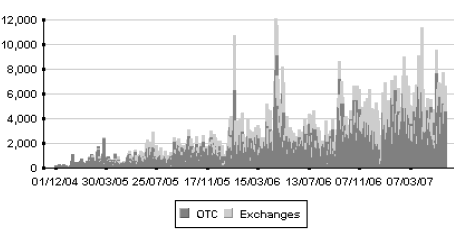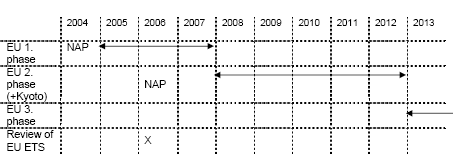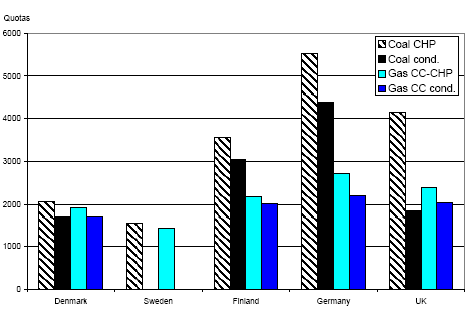Impact of CO2 quota allocation to new entrants in the electricity market
3 The EU ETS
- 3.1 Fundamentals of the EU ETS
- 3.2 Allocation to new entrants
- 3.3 NAP changes from 2005-7 to 2008-2012
In accordance with the Kyoto Protocol the EU15 countries are committed to reducing their greenhouse gasses by 8 percent in 2008-2012 compared to the 1990 level. This overall target has been transferred into national goals for the individual EU member states according to the EU burden sharing agreement. The new EU member states are not encompassed by the burden sharing agreement, but have individual targets of 6 or 8 percent reduction according to the Kyoto Protocol.
The EU’s emissions trading scheme is one of the European Union’s most important measures to combat climate change and to comply with its international commitments. According to the preamble of the ETS directive it should be used as a means to fulfil Kyoto commitments through an ”efficient European market in greenhouse gas emission allowances, with least possible diminution of economic development and employment” (EU 2003/87/EC).
Emission trading begins with a limit or cap on total emissions. By allowing permits/quotas to be traded among stakeholders a market for allowances is created. Economic theory suggests that a trade takes place when a source faces higher marginal costs in reducing its emissions than another source. Market players facing the least costs should be willing to reduce their emissions below their own limit in order to generate permits for sale, whereas market players with high abatement costs should abstain from reducing their emissions. The greater the difference in the marginal costs of reduction among agents, the higher is the benefit of a trading system (IEA/OECD, 2001, OECD, 1993).
3.1 Fundamentals of the EU ETS
The EU ETS includes all EU member states and more than 10,000 production units, including the majority of the energy sector and the energy intensive industry including the off-shore sector. On the EU level app. 45 percent of total CO2 emissions are covered by the scheme corresponding to an annual allocation in the first trial period of approximately 1,800 allowances (1,800 Mt CO2).
The system operates with phases; the first is a trial period going from 2005-2007, i.e. before the commitment period under Kyoto. The second phase runs from 2008-2012 (EU 2003/87/EC, Art. 11) in parallel with the first Kyoto obligation period. Subsequent phases run over 5 years synchronously with the next Kyoto obligation periods.
Every company encompassed by the directive receives an amount of quotas each year and by the 30th of April the following year (EU 2003/87/EC, Art. 12), the companies have to submit quotas to the member state corresponding to their emissions the first year. By placing the deadline for submission of quotas four months within the following year the liquidity of the system is increased because companies by this time have received quotas for the subsequent year. One quota equals the right to emit one tonne of CO2-equivalents in a given period.
By capping emissions from the encompassed companies and by allowing the companies to exchange quotas a market and a price of CO2 are established.
The graph below shows the development of the CO2-price since January 2005 when the EU ETS started. It appears that the price has been quite volatile stretching from 7 to 30 euro/tonne. The steep drop in prices in April 2006 is due to the fact that reported emissions from incumbents were significantly lower than expected by the market.
By end May 2007 quotas for 2007 were traded at app. 0.3 euro/tonne and quotas for 2008 at app. 24 euro/tonne.

Figure 5: The price of CO2 in the EU ETS (Jan. 2005- May 2007) according to Point Carbon 2007 (Carbon Market Europe, 25 May 2007)
As it is seen from Figure 7, market liquidity has been rising ever since the start up of the scheme from less than 1 Mt tonne per day in early 2005 to more than 6 Mt daily today.

Figure 6: Aggregated volumes (kt) of EU allowances traded Over The Counter (OTC) and at exchanges. The graph covers all vintages (allowances for 2005, 2006, 2007 and 2008). Source: www.pointcarbon.com, 30-05-2007.
If a company does not have enough quotas to cover its emissions, it has to pay a penalty of 40 Euro per tonne CO2 in the period from 2005-2007 and 100 Euro per tonne CO2 in the forthcoming periods. Importantly, the payment of the penalty does not release the company from surrendering the missing amount of quotas the following year (EU 2003/87/EC, Art 16).
The number of allowances for the individual production units is specified in National Allocation Plans (NAPs). The NAPs are to be approved by the EU Commission, and the total amount of quotas should reflect the countries’ objectives according to the Kyoto-protocol and the EU burden sharing agreement. According to the EU “Allocations to installations must take account of their potential for reducing emissions from each of their activities, and must not be higher than the installations are likely to need” (EU 2005, EU action against climate change)
In the first allocation period from 2005-7 at least 95 percent of quotas should be allocated to the installations for free, according to the directive and in the second phase this regards 90 percent of the quotas. The remaining quotas may be auctioned off by the member states.
The EU ETS does not require member states to allocate quotas for free to new entrants. In fact, the Commission takes the view, that “having new entrants buy allowances in the market or in an auction is in accordance with the principle of equal treatment.” (EU Commission 2006, COM(2006)676 final). In practice, however, all countries have established a reserve of free allowances for new entrants in the first allocation period. According to EU legislation only fossil fuel plants can be allocated quotas.
As is the case with the governments on the national level, companies under the EU ETS are allowed to use the flexible mechanisms of the Kyoto protocol; Joint Implementation (JI) and Clean Development Mechanism (CDM) to comply with their targets. In the longer perspective it is possible that the EU ETS will merge with similar schemes in other countries with Kyoto-obligations. According to the EU ETS directive “Agreements should be concluded with third countries listed in Annex B to the Kyoto Protocol which have ratified the Protocol to provide for the mutual recognition of allowances between the Community scheme and other greenhouse gas emissions trading schemes”. The extension of the emission trading scheme to global partners is also one the elements in the EU Commissions communication on “External energy relations” from October 2006 (Com(2006) 590 final).
In a first phase relevant countries to link-up to could be Norway, Switzerland and New Zealand and in the longer term for example Russia, Canada or Japan. In addition the EU has considered linking up to the schemes being planned in the North-Eastern States of the US and in California (Point Carbon, 13-11-2006).
By 30 June 2006 the EU member states should have submitted National Allocation Plans for the second emissions trading period (2008-12) to the EU Commission for approval and 1 January 2007 the allocation for individual installations should be finalised.
During 2006-2007 the EU commission reviewed the EU ETS directive examining if amendments are needed in the period beyond 2012 (EU, 15 May 2006: EU emissions trading scheme delivers first verified emissions data for installations). Recently is has been decided to set down a multi-stakeholder working group reviewing the EU emissions trading scheme submitting a report by June 2007 (http://ec.europa.eu/environment/climat/emission/-review_en.htm, 22/12-2006). Adaptations to the design of the EU ETS arising from this review should take effect at the start of the third trading period in 2013 according to the Commission (EU COM(2006)676 final)

Table 3: Overall time schedule of the EU emissions trading scheme. The deadline for the submission of the NAP was the 31st of March 2004 (1st of May for the new member states) for phase 1 and 18 months before the start up of phase 2 (30th of June 2006)(EU 2003/87/EC: Art. 11).
3.2 Allocation to new entrants
The allocation methodologies to new entrants for the period 2005-7 vary from country to country. In some countries the allocation is based solely on the capacity (electric capacity, heat capacity or thermal capacity) or the expected output of the new plant, putting the different fossil fuel technologies on an equal basis. With this allocation principle a new coal fired plant will be allocated as many allowances as a new gas fired plant. This approach is for example used in Denmark and Sweden.
In other countries the allocation to new entrants is technology or fuel dependent. The principle idea is that for instance a new coal fired plant emits more CO2 than a gas fired plant and therefore needs be to be allocated more quotas for its operation. This is for example the case in Germany and Finland.
The table below shows how many quotas Denmark, Sweden, Finland, Germany and the UK allocate to new coal and gas fired plants producing combined heat and power. In Denmark, Finland and the UK allocation depends on the capacity of the power plants whereas it depends on projected generation in Germany and Sweden[3].
| Coal CHP plant | Gas CHP plant | Annotations | |
| Denmark | 1710 Q/MWel + 350 Q/MWheat |
1710 Q/MWel + 350 Q/MWheat |
Allocation is independent of fuel/technology and projected generation |
| Sweden | 212 Q/GWhel + 66 Q/GWhheat |
212 Q/GWhel + 66 Q/GWhheat |
Allocation is based on the plant’s projected generation (GWhel and GWhheat) |
| Finland | 1596 Q/MWthermal | 1212 Q/MWthermal | Assuming base load plants. Peak load plants will be allocated less quotas |
| Germany | app. 750 Q/GWhel + app. 290 Q/GWhheat | app. 365 Q/GWhel + app. 215 Q/GWhheat | Allocation is based on the plant’s projected generation (GWhel and GWhheat) |
| UK | 4130 Q/MWel | 2390 Q/MWel | CHP plants should comply with the requirements for so-called Good Quality CHP (min: 20 % el. eff.). Assuming heat sale for households |
Table 4: Allocation methodologies for new CHP plants in different EU countries. Annual allocation of quotas (Q). Based on NAPs for 2005-7.
The German allocation to new entrants depends on the emissions from the specific plant in question. However, no plant will be allocated more quotas than 750 per GWhel or less than 365 quotas per GWhel. The minimum benchmark of 365 Q/GWhel is based on efficient modern gas power plants. If the emission factor of a specific plant is higher than 365 Q/GWhel the plant owner must supply documentation stating that Best Available Technology is applied.
Table 5 below provides an overview of allocation principles for condensing plants. In Sweden allowances are only allocated to plants producing combined heat and power.
| Coal cond. Plant | Gas cond. Plant | Annotations | |
| Denmark | 1710 Q/MWel | 1710 Q/MWel | Allocation is independent of fuel/technology and projected generation |
| Sweden | 0 | 0 | Condensing plants are not allocated quotas |
| Finland | 1596 Q/MWthermal | 1212 Q/MWthermal | Assuming base load plants. Peak load plants will be allocated less quotas |
| Germany | Max. 750 Q/GWhel | Min. 365 Q/GWhel | Allocation is based on the plant’s projected power generation (GWhel). |
| UK | 1830 Q/MWel | 2030 Q/MWel |
Table 5: Allocation methodologies for new condensing power plants in different EU countries. Annual allocation of quotas (Q). Based on NAPs for 2005-7.
Some countries have specified for how long the new plants will receive allocations. In Germany for example new plants will receive quotas for the subsequent 14 years. In Denmark on the other hand the allocation methodology in principle only accounts for the period 2005-7 and it is therefore uncertain if new plants will receive allowances beyond this period.
Figure 7 below illustrates how new entrant allocation differs between the selected European countries. The graph, which builds on the allocation principles described in Table 4 and Table 5, shows that are significant disparities in the number of quotas for new power plants, particularly for new coal fired units.

Figure 7: Annual allocation to new coal and gas units per MW electricity capacity. In Sweden and Germany allocation is based on projected electricity and heat generation. In the figure we assume 6000 full-load hours of electricity generation for the new units and 4000 full-load hours heat generation for the CHP plants. New plants are assumed to be highly efficient (El-efficiencies for coal condensing: 52.5 % and for gas CC- condensing: 60 %).
3.2.1 Reserves
The annual reserves for 2005-2007 for new entrants in Denmark, Finland, Germany, Sweden and the UK are depicted in the table below.
| Denmark | Finland | Germany | Sweden | UK | |
| Mill. tonne | 1.0 | 0.83 | 3.0 | 0.73 | 15.6 |
| % of total allocation | 3 % | 2 % | 0.6% | 3 % | 6 % |
Table 6: Reserves for new entrants NAPs for 2005-7
In Germany the reserve for new installations is 3 Mt CO2 p.a. in 2005-7 (9 Mt CO2 in total, equivalent to 0.6per cent of the ET budget). It is important to notice that if the actual need exceeds the size of the reserve, additional certificates will be purchased and distributed free of charge. The purchased amount is to be deducted however when the allocation for the second trading period is determined (Umwelt Bundes Amt, 2005).
In Denmark the reserve for new entrants is 1 Mt CO2 p.a. (equivalent to 3per cent of the ETS budget). Allowances are distributed on a “first come – first served” basis and unused allowances in reserve will be cancelled.
Finland has established a reserve of 0.83 Mt CO2 p.a. (2.5 Mt CO2 in total, 2per cent of the ETS budget). Any surplus allowances may be sold by the state.
Sweden has a reserve of 0.73 Mt p.a. (equivalent to 3.2per cent of the ETS budget).
In the UK the reserve for new entrants is 15.6 Mt CO2 p.a. (equivalent to 6per cent of the ETS budget). The reserve will be distributed on a first come – first served basis and any allowances remaining at the end of the phase may be auctioned.
3.3 NAP changes from 2005-7 to 2008-2012
This project builds on the national allocation plans for 2005-7 (NAP I) because to this day Commission decisions on the NAPs for 2008-2012 (NAP II) have not yet been made for all countries under analysis.
A look into the NAP IIs indicates the following main changes:
- Sweden intends to allocate more quotas to new entrants (67 % increase)
- Denmark intends to allocate less quotas to new entrants (30 % decrease)
- The EU Commission has questioned the German 14-year allocation guarantee to new entrants saying that a new power plant can only be treated as a new entrant in one trading period. In the following trading periods the new entrant should be treated on the basis of the general allocation methodology which is used for otherwise comparable existing installations. It is yet to see how this decision will be reflected in the revised German NAP. If the 14-year guarantee is removed this will reduce investor certainty about future allocation to new entrants. However, the EU decision does not say that new entrants in one period may not receive quotas for free in a subsequent period. Therefore it seems probable that new entrants will also receive some level of allocation for the subsequent periods in Germany.
The changes in allocation principles from NAP I to NAP II are not expected to alter the main conclusions of this study.
The changes from NAP I to NAP II are described in more detail for Denmark, Finland, Germany and Sweden below.
3.3.1 Denmark
The NAP II will reduce the allocation to new entrants by 30 per cent compared to 2005-7. Moreover allocation to peak power plants will be reduced. The reserve for new entrants is reduced from 1 Mt annually to 0.5 Mt.
The Commission has not yet made any decision to approve or reject the Danish NAP II.
3.3.2 Finland
No changes compared to the NAP I regarding allocations to new power plants. New entrants during NAP I are also treated as new entrants under NAP II.
The Commission has not yet made a decision to approve or reject the Finish NAP II.
3.3.3 Germany
Germany intends to use the same coal and gas benchmarks as for the 2005-7. Allocation is no longer based on projections of electricity and heat production but on standard factors which are 7500 full-load hours for coal and gas CC.
The 14-year allocation guarantee to new entrants still applies according to the German plan. However, the Commission has subsequently made a decision on the plan saying that a new power plant can only be treated as a new entrant in one trading period. In the following trading periods the new entrant should be treated on the basis of the general allocation methodology which is used for otherwise comparable existing installations. It is yet to see how this decision will be reflected in the revised German NAP.
The reserve is raised to 12 Mt per annum and if the need exceeds the size of the reserve, additional certificates will be purchased and distributed free of charge as it was the case for the first NAP.
3.3.4 Sweden
In order to harmonise allocation with neighbouring countries more quotas are allocated to new entrants than in NAP I. Allocation to electricity producing plants is raised from 202 allowances per MWh projected electricity generation to 337 allowances. Allowances are still only allocated to combined heat and power plants.
An annual reserve of 3 Mt is set a side for each year in the period 2008-2012. This is significantly more than in the first NAP (0.73 Mt per annum).
Footnotes
[3] The Finnish NAP indicates specific emission coefficients per MJ fuel. As full-load hours for new plants are also specified in the plan allocations to new entrants are essentially dependent on the plants’ thermal capacity.
Version 1.0 June 2007, © Danish Environmental Protection Agency